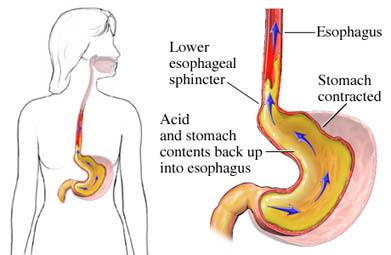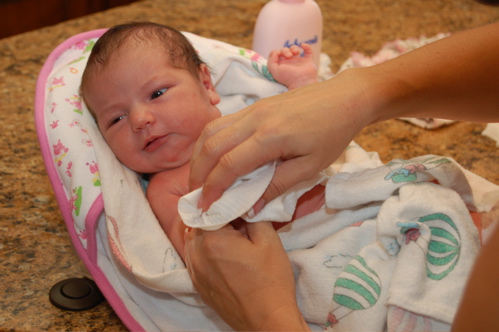Gastroesophageal Refluxin Children and Adolescents

What is gastroesophageal reflux (GER)?
Gastroesophageal reflux occurs when stomach contents reflux, or back up, into the esophagus during or after a meal. The esophagus is the tube that connects the mouth to the stomach. A ring of muscle at the bottom of the esophagus opens and closes to allow food to enter the stomach. This ring of muscle is called the lower esophageal sphincter (LES). Reflux can occur when the LES opens, allowing stomach contents and acid to come back up into the esophagus.
GER often begins in infancy, but only a small number of infants continue to have GER as older children.
What are the symptoms of GER?
Almost all children and adults have a little bit of reflux, often without being aware of it. When refluxed material rapidly returns to the stomach, it does not harm the esophagus. However, in some children, the stomach contents remain in the esophagus and damage the esophageal lining. In other children, the stomach contents go up to the mouth and are swallowed again. When the refluxed material passes into the back of the mouth or enters the airways, the child may become hoarse, have a raspy voice, or a chronic cough. Other symptoms include:
• recurrent pneumonia
• wheezing
• difficult or painful swallowing
• vomiting
• sore throat
• weight loss
• heartburn (in older children)
How is GER diagnosed?
You may want to visit an internist or a gastroenterologist. An internist specializes in internal medicine and a gastroenterologist treats diseases of the digestive system. The doctor can talk with you about your child’s symptoms, examine your child, and recommend tests to determine if reflux is the cause of the symptoms.These tests check the esophagus, stomach, and small intestine for problems. Sometimes a doctor will start treatment without running tests if the symptoms bly indicate GER.
The most common tests used to diagnose GER are the following:
Upper gastrointestinal (GI) series x ray. X rays are taken to check for damage to the esophagus, stomach, or intestines. First, a chalky drink called barium is swallowed, which makes the images on the x rays easier to see. A doctor cannot make a diagnosis of GER based on x rays alone, but x rays help rule out other problems that cause the same symptoms as GER.
Endoscopy. A sedative is given before this procedure to make the child sleepy. A small, flexible tube with a very tiny camera on the end is then inserted through the mouth and esophagus and into the stomach. The camera gives the doctor a view of the lining of the esophagus, stomach, and small intestine by transmitting the images onto a television screen. During the endoscopy, the doctor can also remove a small piece of tissue in a procedure called a biopsy. Looking at the tissue with a microscope helps the doctor determine the level of acid damage and rule out problems.
Esophageal pH probe. A thin, light wire with an acid sensor at its tip is inserted through the nose into the lower part of the esophagus. This probe detects and records the amount of stomach acid coming back up into the esophagus and indicates whether acid is in the esophagus when the child has symptoms such as crying, coughing, or arching her back.
Speak with your child’s health care provider if any of the following occur:
• increased amounts of vomiting or persistent projectile (forceful) vomiting
• vomiting fluid that is green or yellow or looks like coffee grounds or blood
• difficulty breathing after vomiting or spitting up
• pain related to eating
• food refusal that causes weight loss or poor weight gain
• difficult or painful swallowing
 What is the treatment for GER?
What is the treatment for GER?
Treatment for reflux depends on the child’s symptoms and age. The doctor or nurse may first suggest a trial of medication to decrease the amount of acid made in the stomach when a child or teenager is uncomfortable, has difficulty sleeping or eating, or fails to grow.
H2-blockers, which are also called H2- receptor agonists, are one class of medication often tried first. These drugs help keep acid from backing up into the esophagus. They are often used to treat children with GER because they come in liquid form.
H2-blockers include
• cimetidine (Tagamet)
• ranitidine (Zantac)
• famotidine (Pepcid)
• nizatidine (Axid)
A second class of medications often used to reduce stomach acid is proton-pump inhibitors (PPIs), which block the production of stomach acid. PPIs have few side effects, but those that have been reported are constipation, nausea, and headaches.
This class of drugs includes
• esomeprazole (Nexium)
• omeprazole (Prilosec)
• lansoprazole (Prevacid)
• rabeprazole (Aciphex)
• pantoprazole (Protonix)
A third class of medications used to treat GER is prokinetic agents. Prokinetic agents make the LES close tighter so stomach acid cannot reflux into the esophagus. These drugs are often used in combination with acid reducers.
Prokinetic agents include
• metoclopramide (Reglan)
• cisapride (Propulsid)
• erythromycin (Dispertab, Robimycin)
• bethanechol (Duvoid, Urecholine)
Serious side effects have been reported in adults and children taking metoclopramide and cisapride, including confusion, anxiety, diarrhea, and nausea. People taking prokinetic agents should tell their doctor if they are taking other medications because there could be an adverse drug reaction.
Besides using medication, you may be able to reduce symptoms other ways.
• Have your child eat more frequent smaller meals.
• Have your child avoid eating 2 to 3 hours before bed.
• Raise the head of your child’s bed 6 to 8 inches by putting blocks of wood under the bedposts. Just using extra pillows will not help.
• Have your child avoid carbonated drinks, chocolate, caffeine, and foods that are high in fat or contain a lot of acid (citrus fruits) or spices.
For Adults:
Elevate the head of the bed 6 inches
Stop smoking
Stop consuming excessive alcohol
Reduce fat in diet
Reduce size of meals?
Avoid eating at bedtime
Lose weight (if overweight)
Avoid wearing tight-fitting clothes
Avoid certain foods
Chocolate
Carminatives (eg, spearmint, peppermint)
Coffee (eg, caffeinated and decaffeinated)
Tea
Cola beverages
Tomato juice
Citrus juices
Avoid certain drugs, when possible
Anticholinergics
Theophylline
Diazepam
Narcotics
Calcium channel blockers
-Adrenergic agonists (isoproterenol)
Progesterone (some contraceptives)
-Adrenergic antagonists (phentolamine)
If the child continues to have symptoms despite initial treatment, tests may be ordered to help find better treatments. Surgery for GER in children is rare. However, surgery may be the best option for children who have severe symptoms that do not respond to medication.
If surgery is needed, a fundoplication will be performed.
During a fundoplication the upper part of the stomach is wrapped around the LES. This procedure adds pressure to the lower end of the esophagus and reduces acid reflux.
Your child’s doctor can discuss the treatment options with you to help your child feel well again.
* The authors of this fact sheet do not specifically endorse the use of drugs for children that have not been tested in children (“off label” use). Such a determination can only be made under the recommendation of the treating health care provider.
Points to Remember![]()
• GER occurs when stomach contents back up into the esophagus.
• GER is common in infants, but most children grow out of it.
• GER may cause vomiting, coughing, hoarseness, or painful swallowing.
• Treatment depends on the child’s symptoms and age and may include changes in eating habits and taking medications. Surgery may be an option.

